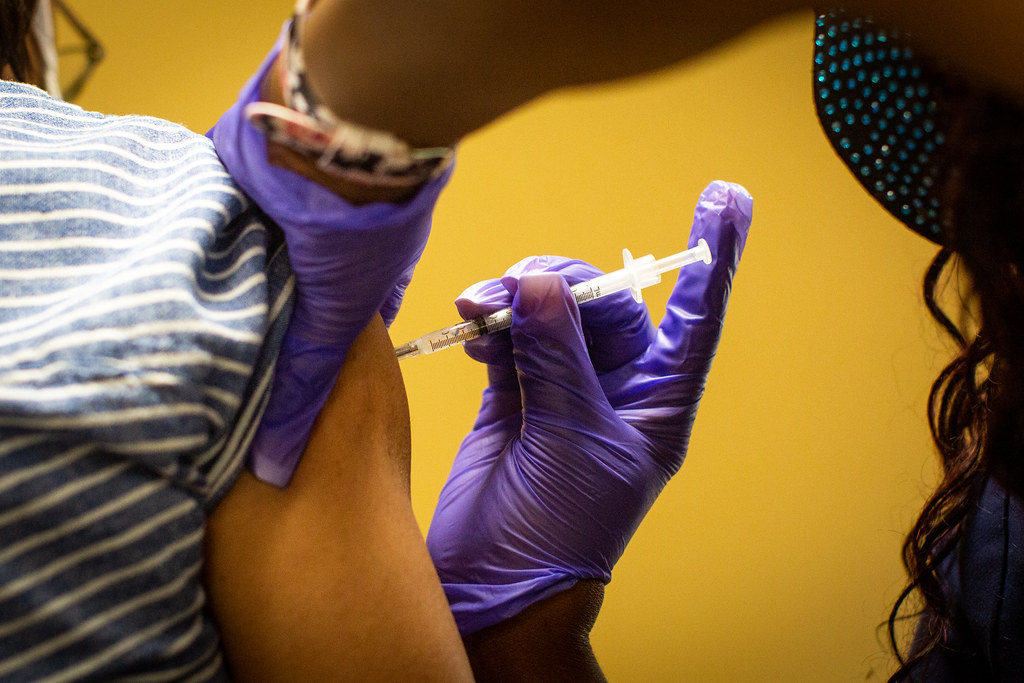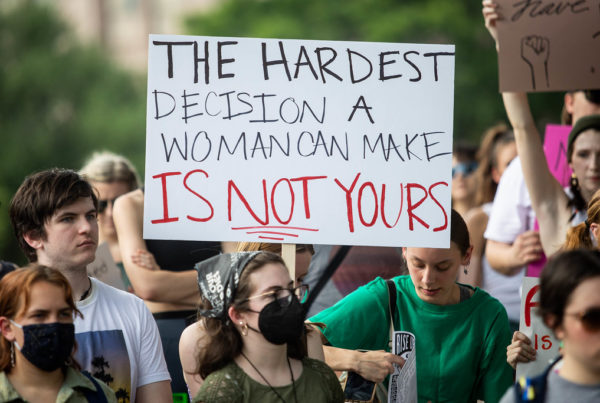Last week, federal health officials announced approval for new COVID booster shots, ones with an extra kick: These new vaccines are aimed at helping to control both the original coronavirus strain and the omicron subvariants, known among doctors as BA.4 and BA.5.
Now, those vaccines are arriving in Texas – and along with them, many questions. With cases, deaths and hospitalizations due to COVID all trending lower, the sense of urgency experienced during that first so-called alpha wave of cases has largely subsided. But one of the nation’s leading experts on COVID is warning against complacency, especially with kids back in school and many Texans returning to pre-pandemic routines.
Dr. Peter Hotez, dean for the National School of Tropical Medicine at Baylor College of Medicine in Houston and co-director of Texas Children’s Hospital Center for Vaccine Development, joined Texas Standard to answer questions about the newest vaccines.
What’s different about these omicron-specific boosters?
The mRNA vaccines that we’ve been getting and boosted with is what’s called a monovalent vaccine, Hotez said, meaning it’s mRNA that only encodes for an antigen corresponding to the original lineage coming out of central China. The new booster is actually two mRNAs: One of the original lineage, plus a new one that’s more specifically tailored to protect against the BA.5 subvariant that’s currently prevalent in Texas and the United States.
Can all Texans get these shots, or are they only for people of a certain age?
Moderna’s updated booster is for anyone 18 and older, and Pfizer’s is for anyone 12 and older, Hotez said. Children ages 5 to 11 and eligible for boosters would still have to boost with the original mRNA vaccine.
“I wouldn’t hold off. If your child is eligible for a booster, go ahead and get it,” he said. Only about 8% of kids under the age of 18 in the U.S. have gotten any booster, and in Texas number is closer to 4%.
Who is eligible for the new boosters? Can anyone get it regardless of their current vaccine/booster status, or alongside a flu shot?
You should be able to get the new one – and you shouldn’t wait, Hotez said.
“In the past, when we’ve spoken about people getting hospitalized, overwhelmingly, it’s people who aren’t vaccinated. So last year at this time, as we were heading into the Delta wave, 85% of those hospitalized were the unvaccinated,” he said. “Now that vaccine protection is declining, we are seeing hospitalizations among people who just got the two shots but didn’t get the booster. And so it’s really important you get the booster. And even if you’ve got the single booster now, if you’re over the age of 50, you definitely want to get the second booster and likely now under the age of 50, you’re eligible for this new one.”
People are eligible if it’s been at least two months since their last vaccine or booster, Hotez said, and they can also get a booster shot and flu shot at the same time.
“And if it’s convenient, you know, you can get one in one arm and another in the other,” he said. “If you’re uncomfortable with doing that, that’s fine, too. By the way, I just got my flu shot at H-E-B, so go into H-E-B or CVS or or wherever and get your flu shot, too.”
» MORE: U.S. preparing to roll out omicron boosters, but distribution faces challenges
Is there an issue of safety?
“The thinking is that, look, these different mRNAs have been tested in people during this pandemic. Right now in the UK, for instance, they’re using a different mRNA to the original omicron, the BA.1, and it’s been going well,” Hotez said. “So the thinking is that the mRNA technology is similar enough between the different variants, that it’s a high probability of safety. And so far, we’ve not heard about any major issues.
“I think the bigger question is going to be, does it work in the sense that does the mRNA to the BA.5 induce an immune response to BA.5? And you might say, well, of course, why wouldn’t it? Well, the answer is, since people have been immunized and boosted so much with the original lineage, does that kind of skew the immune response and make it more difficult to respond to the BA.5? And in mice, that’s not the case. But we won’t know in humans until we know. So I think that’s the only question mark.
“But there’s no downside of getting this combination booster, so I’m enthusiastic to get it. My wife got it. So I think, you know, this is going to be the way to go because right now, BA.5 is the dominant circulating strain, number one. And number two, we don’t know what’s out there. And so this is the other big question mark that people don’t talk about a lot, which is that we’re expecting perhaps another major variant of concern come this winter, just like we saw last winter and the winter before. And the big unknown is what that’s going to look like. And by being boosted with a vaccine that’s got both the original lineage and BA.5, it gives you two shots on goal to make it more likely you’ll be able to respond to whatever is coming down the pike.
As hospitalizations and death counts trend lower, many people are thinking, ‘well, omicron’s been with us.’ Why the urgency now?
While COVID is not the leading cause of death on a daily basis in the U.S., it’s still the third or fourth leading cause of death on a daily basis, Hotez said, with 400-500 or sometimes 600 deaths a day.
“And the reason it’s mitigated somewhat is because so many people by now have either been previously infected, or infected and vaccinated, or vaccinated, some combination of that. So on a population level, it’s having some mitigating effects, but that doesn’t really help inform you much about an individual health decision,” he said. “So the bottom line is, if you’re unvaccinated totally, you’re at high risk of being hospitalized or worse if you get BA.5, and even if you’ve gotten two doses a long time ago, you’re at high risk of hospitalization. And if you’re more than four or five months out of a booster, you have some risk as well.
“So the key is to be mindful of your own vaccination situation and keep up with your boosters. You know, I know it’s not fun. It’s disappointing, right? Because we were hoping the vaccination series would do it or getting boosted would do it. But the reality is, the protective effect against the boosters is not holding up quite as well as we’d like. It’s still pretty good, but not as great as we like. So you do have to be mindful of keeping up with your boosters.”
What is the long-term outlook for COVID? Should we expect a routine yearly shot?
There’s not consensus in the scientific community, Hotez said. The White House has said COVID boosters will be come an annual shot; that may be true, but there’s not yet the data to support that, he said.
“We’ve first got to see how well we’re responding in terms of the BA.5 component of this booster. We don’t have good predictive algorithms or models to know what new variants of concern are arising out there, how long the protection’s going to last,” Hotez said. “And of course, we also have the reality that not many of the American people are actually taking the boosters. Only about 30% of Americans who are eligible took the first booster; less took the second booster. And who knows who’s going to take this one?
“I mean, I’ll get it. And my colleagues are getting it because we understand the importance. But it’s been a tough message to present to the American people. So we’ve got to do a better job on that. And I’m really worried during the school year now, we need to get our teachers boosted and our school staff boosted. That’s going to be really important.”













